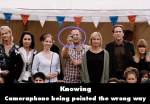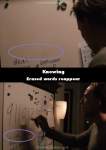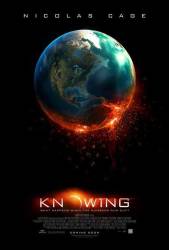Continuity mistake: In the opening 1950s school scene, the children all run up the front steps of the school. A little blonde girl wearing an orange cardigan and white dress is seen running up the stairs to the school building. A few seconds later the same girl is seen running towards the school again - from further back. (00:01:45)
Character mistake: The blackboard in the opening school sequence shows the phrase "The quick brown fox, jumped over the lazy dog" this is incorrect. It should read, "The quick brown fox jumps over the lazy dog." The point of the sentence is that it contains all of the letters of the alphabet, but in the first example, there is no 's'. (00:03:07)
Continuity mistake: When Nicholas Cage is watching Tigers under threat, he pours himself a drink. He ends up overfilling the glass, resulting in him spilling on the floor. It sounds like the scotch hits a wooden or tile floor, yet when the angle changes he would have spilled on a rug. Here the wet spot on the rug is also magically gone. (00:21:30)
Revealing mistake: In the scene where John first discovers the patterns of numbers, he writes all of the numbers on his whiteboard. He circles the numbers he finds online with a colored marker. When he circles the number 2708 with the blue marker, he passes over the 8 with the marker, but the original black 8 and part of the 0 appears on top of the blue, showing that it was done using some overlay technique. This same effect is shown several times including when the blue and red pens mix but are still behind the black. (00:24:55)
Suggested correction: Black marker is never on the top of the blue, blue marker is simply transparent, so you can see black marker through it.
Factual error: Almost at the end of the movie, when John is driving in a crowded street just before joining with his parents, there is a shot showing a Water Delivery Service Car fully charged which is not possible due to the emergency. It is supposed to be empty because of people taking water for themselves. (01:51:10)
Character mistake: The newspaper article states that Lucinda was thirty-three at the time of her death in 1988. However, that would make her just four years old when she wrote the time capsule note in 1959 - four years old in the 3rd grade?
Revealing mistake: When John is stuck in traffic and he walks up to the other man asking if anyone was hurt, the guy looks behind John's shoulder as if the plane is coming right behind him. Then John turns around and looks right behind him as well. But the camera then pans all the way to the side to see the plane coming in before it crashes - they were looking in the wrong place.
Continuity mistake: When John is driving to the gas station, the back door of his car is missing, although it was there when he was driving from his house.
Revealing mistake: After the plane has crashed, the camera turns around and looks at John, as he watches the plane crash. There is a first row of cars with a line of fire burning behind them, yet people are still sitting in their cars looking directly forward as if nothing happened.
Continuity mistake: The truck John drives in the movie constantly changes from one model to another depending on an exterior vs. and interior shot. The exterior shots are using an XL edition F150 while the interior shots are from an FX2 edition F150.

Other mistake: During the time capsule recovery ceremony, there is a man standing next to Nicolas Cage, who pulls out his cell phone to take a picture of the ceremony. However, he's holding the cell phone wrong, pointing the camera towards himself.
Factual error: When New York is destroyed by the fireball, the Times Square giant TV (& other electrical items) is still on (although no picture - just static), but the super-flare would cause electrical items to overload before the main fireball hit, almost like an EMP.
Factual error: When John Kostler arrives in New York from Massachusetts, they pan out and show him crossing the Brooklyn Bridge. There is no logical way, on the route to Manhattan from New England, that one would cross this bridge. It would require him to travel completely out of the way, and judging by the competence of the protagonist, it becomes obvious this was used for visual effect only.
Revealing mistake: John is stuck in traffic and talking on his mobile phone on the highway just before the plane crashes. On the right-hand side of the screen, there's a car (Hyundai) visible through John's car side window. The car has number plates of Victoria, Australia where this particular scene was shot.
Factual error: Cell phone signals are repeatedly blocked by electromagnetic radiation from the sun. However, GPS devices, which receive a much fainter signal from satellites, continue to operate. For that matter, television broadcasting, which relies on satellite relays, continues until the end of the film.
Continuity mistake: When John gets out of his truck on the highway to talk to the cop, his windshield wipers change speed. While he is still inside the truck the wipers move slowly, but they move a lot faster as soon as he steps out of the truck.
Continuity mistake: In the scene where John and Diana are searching Lucinda's trailer, when the horn blows they rush outside. John unlocks the glove box and gets his gun, leaving the keys hanging in the lock, then outside the truck, he hands the keys to Diana.
Continuity mistake: At the museum, John and Diana are talking at a table while the kids are playing together. There is an empty glass with a blue straw in front of John. Sometimes, the straw points away from him, sometimes it points towards him.
Suggested correction: The straw never points in the different directions throughout the scene, it alwaysstands there almost the same way.

Continuity mistake: When John is decoding the numbers for the first time, he uses a whiteboard. On the whiteboard are, presumably, spelling words for Caleb. He erases some of these to make room for the numbers. In the various shots of this scene, words disappear and reappear continuously, often written slightly different.
Factual error: In the scene where Nic Cage sits at his computer and discovers what will destroy the world, he describes it as "A super-flare. A 100 microtesla wave of radiation that would destroy our ozone layer, killing every living organism on the planet." First, "tesla" is a measure of magnetism, not radiation, and 100 microtesla is a very weak magnetic field - an MRI machine uses around 3 Tesla. Second, destruction of the ozone layer would eventually kill all life on the planet, slowly, through radiation poisoning. It would not burn the planet to a cinder, as depicted in the movie.





